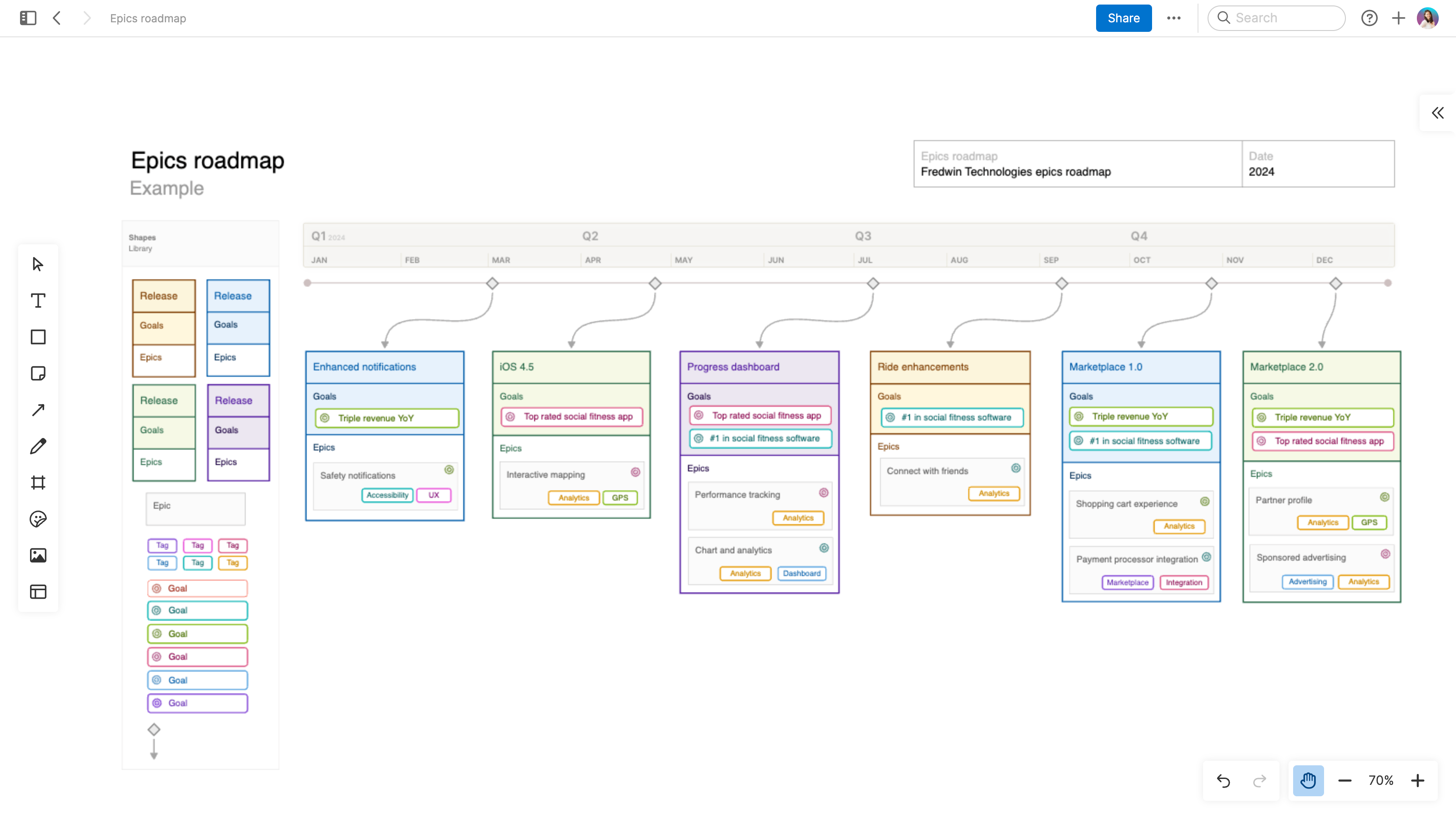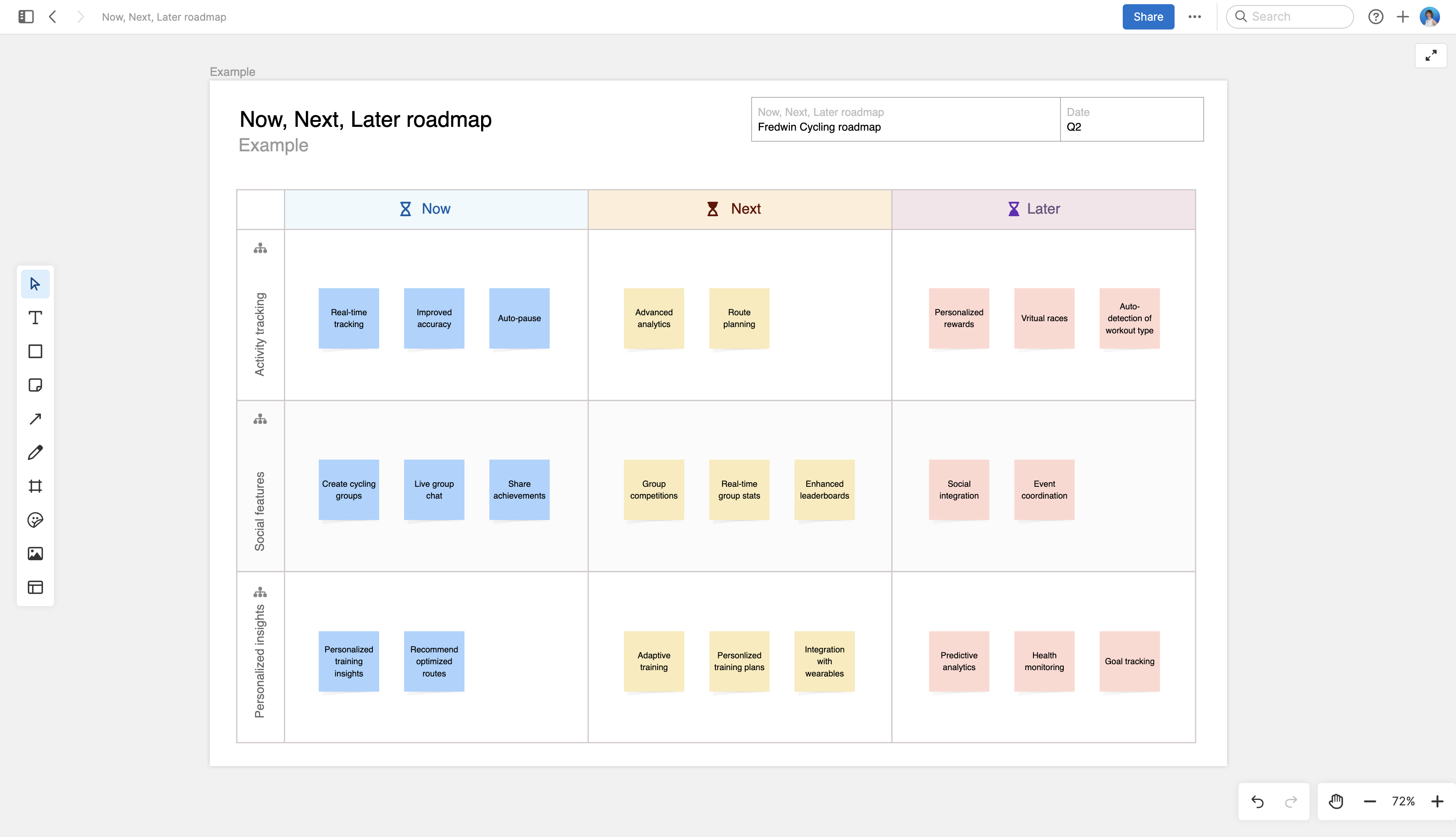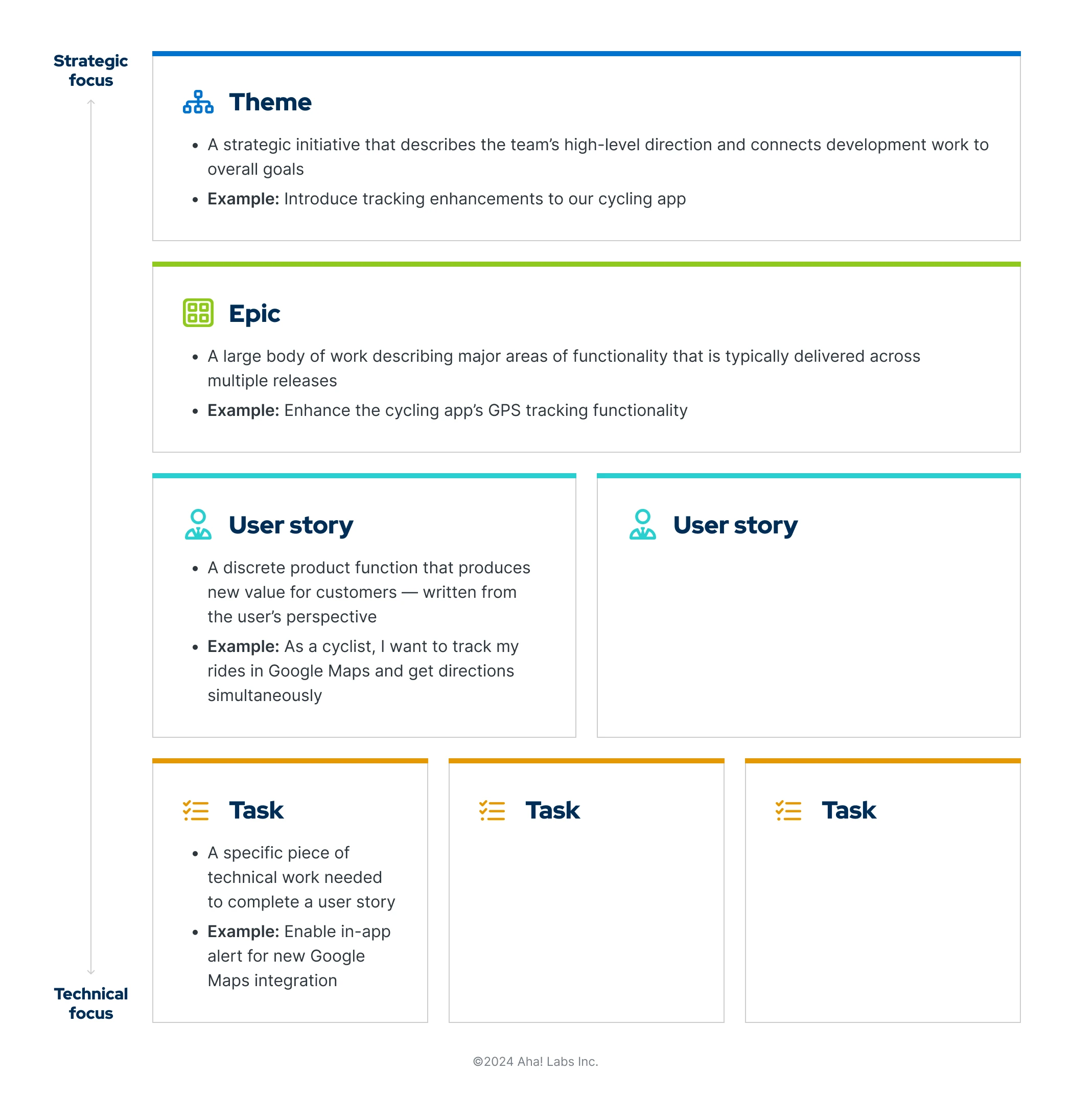Agile epics explained: Definition, examples, and best practices
Clear, practical answers for how epics actually work in your roadmap
Last updated: November 2025
An epic is a collection of related features that roll up to a strategic initiative: a way to organize big ideas into work that is delivered across multiple releases. This guide answers the most common questions about epics and shows how to connect them to goals, roadmaps, and releases. (You will also see how tools like Aha! software can help along the way.) |
Most guides stop at "an epic is a large body of work." That is true, but it misses the real question: What purpose do epics actually serve? Too often, teams treat them as nothing more than containers for features. But in reality, epics bring structure and meaning to your product plans, helping you group related work around shared outcomes.
Looking for a clear, practical take on epics? You are in the right place.
For this guide, we gathered the common questions product teams ask most and answered them simply, with context that connects to your everyday planning. You will see that epics are more than just a container on your roadmap. They connect strategy to delivery and help you organize big goals into meaningful progress. Understanding them also makes it easier to communicate plans and results across teams. Let's start there.
Feel free to skip ahead to any section:
What are epics in agile product development?
An epic brings together related features and user stories that contribute to the same goal. Typically, this work spans multiple sprints or releases. Beyond defining scope, epics give structure to your planning. They help you translate high-level initiatives into specific, actionable work, bridging the space between strategy and daily delivery. You can think of them as the connective tissue that keeps long-term goals aligned with what teams are actually building.
For example, in Fredwin Cycling — our fictitious product for cyclists — a few epics might include:
Enhancing GPS tracking for more accurate ride data
Introducing performance dashboards so riders can analyze speed, distance, and elevation
Updating pricing plans and subscription tiers to better match how cyclists use the app
Use epics to break down complex work into clear stages. Start with an initiative (often called a theme in agile), organize related efforts into epics, and then define the individual stories and tasks that bring each one to life.
In the following visual, you can see how these elements connect in a typical product planning hierarchy.
Related:
Why do product teams create epics?
Epics bring order to ambitious work. Each one defines a shared outcome and gives everyone a clear view of who is leading the work and how it ties back to strategy. They also make progress visible across releases — so instead of tracking dozens of individual features, you can see how the larger effort is moving forward.
And because all the related work lives in one place, epics make it easier to plan, adjust, and communicate updates as you go. They keep the team aligned on the goal and focused on delivering meaningful value over time.
Common questions about epics
How are epics different from features, user stories, or initiatives?
It is easy to mix up these terms because they all describe levels of work that help shape complex product plans. The difference lies in scope and purpose.
Initiatives (sometimes called "themes" in agile) are investments that support an overall business or product goal.
Epics are large bodies of work made up of multiple features that work together to achieve one outcome.
Features and user stories are the functional components that describe how you will deliver specific capabilities.
Level of work | Description | Time frame | Example |
Initiative | Strategic investment area | Typically quarterly or annual | Improving the onboarding experience |
Group of related features achieving one outcome | Usually spans multiple releases | Onboarding flow for a new user | |
Individual capability or enhancement | Within one release or sprint | Adding a guided setup wizard | |
Specific user need or scenario | Within one release or sprint | Offering a new user a step-by-step setup so they can get started quickly |
Together, these layers create a hierarchy that helps you manage large goals and translate strategic priorities into actionable work.
Related:
Do epics replace releases?
No. Epics and releases work together but serve different purposes. An epic defines a body of work tied to a specific outcome, while a release shows when parts of that work will be delivered. Most epics span multiple releases, especially when the effort requires several iterations to complete. Tracking epics alongside releases helps you show both progress toward the goal and the timing of delivery.
Learn more from our Aha! knowledge base ➡️ Use epics across releases and workspaces.
When should I create an epic?
Create an epic when a single goal or feature set is too large to complete in one sprint or release. Epics are helpful any time you need to coordinate related work across teams, track progress over time, or connect multiple deliverables to a shared goal.
Epics can be useful in different scenarios and across many teams:
Product teams use epics to group several user stories under one clear objective.
Marketing or operations teams rely on them to manage campaigns or projects that span multiple schedules.
IT or engineering teams might use them to coordinate infrastructure updates or platform migrations across releases.
Here is a good test: If the work delivers a distinct customer or business outcome — not just a feature enhancement — and will require coordination across multiple releases or teams, it is probably an epic.
How long should an epic take to complete?
The duration of an epic depends on your release cadence and the value you aim to deliver (not a fixed time box).
Some teams release weekly and complete epics in a few weeks. Others plan quarterly or annually, with epics that span months. For example, redesigning an onboarding flow might wrap up within a few iterations, but introducing a new product area could take a full quarter or more. What is important is maintaining a steady flow of progress toward the outcome you defined. Review each epic regularly to confirm it still reflects current priorities as feedback and dependencies evolve.
How do you write a good epic?
A strong epic tells a clear story about what you are trying to achieve and why. It defines the outcome without diving into every detail of how you will get there.
When drafting an epic, focus on four essentials:
Goal and initiative: Show which strategic objective this work supports.
Description: Outline the problem or opportunity, plus the value it will deliver.
Scope: Note the major features or user stories that will bring the epic to life.
Time frame: Provide expected timing (by release)
Keep the description high-level. Details such as design decisions or technical tasks belong in the features that roll up to your epic.
In Aha! Roadmaps, epics stay dynamically connected to those underlying features — so you can see progress, dependencies, and impact all in one view.
You can also visualize and plan your epics on a roadmap to show timing and dependencies. Try the epics roadmap template to see how all of this comes together.

How do epics fit in an agile roadmap?
On a roadmap, epics typically sit between initiatives (your strategic themes) and features (your deliverables). They show when you plan to deliver major collections of work. By visualizing high-level plans on a release timeline, the team can better prioritize features, clarify requirements, and track progress as work gets underway.
Epics bring structure to agile planning. They give you a way to connect the day-to-day work happening in sprints to the larger goals driving your roadmap.
The epic provides direction even if every feature is not defined upfront. You can start with the outcome you want to achieve, add features as you learn more, and adjust plans across upcoming releases. This balance of flexibility and structure keeps agile roadmaps strategic — helping stakeholders focus on outcomes rather than sprint details.
Related:
Who is responsible for creating and maintaining epics?
Product managers or product owners usually create and own epics. They define the goal, outline the scope, and ensure each feature contributes to the outcome the team wants to achieve. As work progresses, engineers and designers add context and details. Keeping an epic up to date is a shared effort. Everyone plays a role in delivering the result and maintaining visibility into what is happening.
Best practices for managing epics
Epics work best when they stay connected to strategy and reflect what is really happening across your teams. Here are a few ways to keep them organized in Aha! Roadmaps:
Link epics to strategy: Connect each epic to a goal or initiative so it is clear how the work supports your broader direction. This gives everyone visibility into why the work matters and how it contributes to shared success.
Tailor epic records to your workflow: Adjust terminology, statuses, and layouts to match how your team plans and delivers work. You can add custom fields to capture details such as effort estimates, target release dates, customer impact, or priority scores.
See progress across releases and workspaces: Group features by epic on a Gantt chart to view timing, dependencies, and delivery status. Because epics can include features from multiple workspaces, you get one complete view of progress across teams.
Collaborate where the work happens: Add comments, to-dos, and research directly within each epic. Link related ideas, interviews, and whiteboards to keep customer insights close to the plan.
Report on progress and results: Create reports and roadmaps that highlight how epic-level work contributes to strategic goals. Views like the Now, Next, Later roadmap work especially well when not every feature is defined. It helps you show what is in progress, what is coming soon, and what is planned for the future. This makes it easy to connect ongoing work to the original intent behind each epic.

Epics, features, and initiatives all serve the same purpose: helping teams stay aligned on what they are building and why. The labels matter less than the intent behind them. When everyone understands how their work connects to a shared direction, it becomes easier and progress is more meaningful. That is the real value of organizing work with epics.
